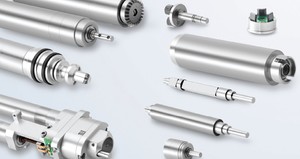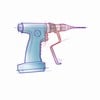Slotted Motor Design Challenges and Opportunities
Featured Product from Portescap

Challenges and Opportunities in Miniature Slotted Motor Design
The high torque density and enhanced cooling capability of miniature brushless DC (BLDC) slotted motors are instrumental in numerous applications ranging from robotics to consumer electronics. However, to optimize the efficiency, performance, and reliability of the application, their specification requires careful consideration. Engineering integration advice in the selection of off-the-shelf slotted BLDC motors is advantageous, and considerations on bespoke design will benefit the application’s performance in the long term.
With the absence of brushes for the process of commutation, miniature brushless DC motors have advantages over their brushed counterparts, including improved efficiency, high speed operation, longer lifespan, and opportunities for improved control. Within BLDC motors, there is a design choice for either slotted or slotless configurations.
The stator, which is the outer stationary part surrounding the rotor, contains the windings that channel the flow of electric current. This generates a magnetic field that interacts with the rotor’s magnets, causing it to rotate and create motion. In a slotless BLDC motor, the windings are typically secured in the stator by resin or are held in place by a tape or mechanical retention device. Alternatively, in a slotted design, windings are retained within slots or grooves.
Slotless motors are generally more compact, and these designs are also beneficial for applications that require the smoothest operation and high speed. However, slotted BLDC motors enable an increase in the amount of magnetic flux density in the airgap, which results in higher torque generation; this helps improve the motor’s dynamics, making this design more reliable. The slots also help to dissipate heat, enabling improved cooling.
SIZING SLOTTED BLDC MOTORS
Slotted BLDC motors present unique challenges during the design phase, meaning that careful specification is required. This includes accurate core loss calculation, as well as the accountability of material saturation and magnet demagnetization at higher operating temperatures, which can impact performance, efficiency, and thermal management. Sizing the motor to meet the torque requirement is a critical step. This calculation depends mainly on the electrical and magnetic loadings, alongside rotor and stator dimensions and the selection of the materials.
As a broad principle, if the application’s working points involve high speed and low torque, magnetic loading must be optimized to lower core losses with a smaller number of pole pairs. Core losses, also known as iron losses, refer to the energy dissipated in the motor's magnetic core as a result of hysteresis and eddy currents. At the other end of the scale, if the working points include low speed and high torque, the electrical loading must be optimized to deal with copper losses (also known as I²R losses). Copper losses represent the resistance of the windings to the flow of electric current, and present as lost power in generated heat. Lowering core and copper losses will optimize motor efficiency for the given torque-speed working points.
The basic relationship between the generated torque is given by the following equation: (Read the whitepaper on our website to see the equation)
AN OVERVIEW OF SLOT-POLE COMBINATIONS
The arrangement/relationship between the stator slots and the permanent magnet poles on the rotor is known as the slotpole combination, which describes the motor’s magnetic field interactions.
There are different slot/pole combinations possible with miniature slotted motors. A high winding factor should be considered to increase the torque constant of the motor. A high LCM, or Least Common Multiple, between the number of slots and poles (S, P), reduces the cogging torque magnitude, while a high GCD, or Great Common Divisor (S, P) helps to reduce the unbalanced magnetic radial forces and increase the radial symmetry.
Traditional Intergral Slot Concentrated Windings (ICSW) two-pole slotted design shown in Fig.1 is possible, but the torque constant is lower than the four-pole design; this option is not recommended for high-torque, low-speed applications.
Various combinations are available dependent on the desired torque and speed, as well as the motor’s ability to deal with characteristics such as cogging torque, which creates torque ripples and impacts the smoothness of motion delivery.
In addition to the slot-pole combination, another configuration known as fractional slot concentrated windings (FSCW) is also possible. FSCW includes multipole ring magnet configurations with short magnetic circuits, and this design is suitable for low-speed, high-torque applications. Table 1 identifies the various slot-pole combinations and their benefits.
SPECIFYING MINIATURE SLOTTED BLDC MOTORS
The motor’s generated torque is proportional to its volume, the magnetic and electrical loading, and its slot-pole combination.
Specifying these characteristics is dependent not only on the application’s torque-speed requirements, but also wider attributes that can impact motion performance, as well as reliability and longevity.
When specifying a slotted BLDC motor, off-the-shelf stator slot shape patterns and standard magnet configurations developed over many years of production can provide high reliability and sufficient performance if the motor size is standard. However, this traditional design typically has suboptimal utilization of the magnetic circuit, which also means lower efficiency at certain torque-speed working points.
Considering the array of factors that impact specification, seeking engineering integration support from a motion specialist
such as Portescap is crucial. This is especially the case for higher volume OEMs. Bespoke motor design is extremely beneficial, as this approach can optimize performance and efficiency for the specific working points; based on customizable existing designs, time to market is also often faster than using an off-the-shelf design when all stages of integration are considered. Slotted BLDC motors can also be specified for their cost-effectiveness, and considering the increased value that a bespoke design can provide, this process has the potential of lowering total costs.
To find out more about brushless DC motor specifications and designs tailored to your application, contact the Portescap team at https://www.portescap.com










